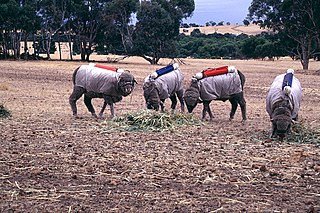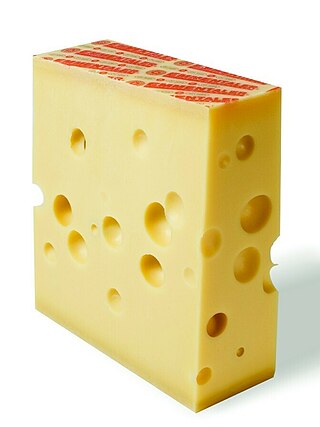Related Research Articles

Ruminants are hoofed herbivorous grazing or browsing mammals that are able to acquire nutrients from plant-based food by fermenting it in a specialized stomach prior to digestion, principally through microbial actions. The process, which takes place in the front part of the digestive system and therefore is called foregut fermentation, typically requires the fermented ingesta to be regurgitated and chewed again. The process of rechewing the cud to further break down plant matter and stimulate digestion is called rumination. The word "ruminant" comes from the Latin ruminare, which means "to chew over again".

Propionic acid is a naturally occurring carboxylic acid with chemical formula CH
3CH
2CO
2H. It is a liquid with a pungent and unpleasant smell somewhat resembling body odor. The anion CH
3CH
2CO−
2 as well as the salts and esters of propionic acid are known as propionates or propanoates.

Obligate anaerobes are microorganisms killed by normal atmospheric concentrations of oxygen (20.95% O2). Oxygen tolerance varies between species, with some species capable of surviving in up to 8% oxygen, while others lose viability in environments with an oxygen concentration greater than 0.5%.
Acidogenesis is the second stage in the four stages of anaerobic digestion:
The rumen, also known as a paunch, is the largest stomach compartment in ruminants and the larger part of the reticulorumen, which is the first chamber in the alimentary canal of ruminant animals. The rumen's microbial favoring environment allows it to serve as the primary site for microbial fermentation of ingested feed. The smaller part of the reticulorumen is the reticulum, which is fully continuous with the rumen, but differs from it with regard to the texture of its lining.
Acetogenesis is a process through which acetate is produced either by the reduction of CO2 or by the reduction of organic acids, rather than by the oxidative breakdown of carbohydrates or ethanol, as with acetic acid bacteria.

Enteric fermentation is a digestive process by which carbohydrates are broken down by microorganisms into simple molecules for absorption into the bloodstream of an animal. Because of human agricultural reliance in many parts of the world on animals which digest by enteric fermentation, it is the second largest anthropogenic factor for the increase in methane emissions directly after fossil fuel use.
Fibrobacterota is a small bacterial phylum which includes many of the major rumen bacteria, allowing for the degradation of plant-based cellulose in ruminant animals. Members of this phylum were categorized in other phyla. The genus Fibrobacter was removed from the genus Bacteroides in 1988.

In biochemistry, mixed acid fermentation is the metabolic process by which a six-carbon sugar is converted into a complex and variable mixture of acids. It is an anaerobic (non-oxygen-requiring) fermentation reaction that is common in bacteria. It is characteristic for members of the Enterobacteriaceae, a large family of Gram-negative bacteria that includes E. coli.
Microbial metabolism is the means by which a microbe obtains the energy and nutrients it needs to live and reproduce. Microbes use many different types of metabolic strategies and species can often be differentiated from each other based on metabolic characteristics. The specific metabolic properties of a microbe are the major factors in determining that microbe's ecological niche, and often allow for that microbe to be useful in industrial processes or responsible for biogeochemical cycles.
The reticulorumen represents the first chamber in the alimentary canal of ruminant animals. It is composed of the rumen and reticulum. The reticulum differs from the rumen with regard to the texture of its lining. The rumen wall is covered in small, finger-like projections called papillae, whereas the reticulum is lined with ridges that form a hexagonal honeycomb pattern. The ridges are approximately 0.1–0.2 mm wide and are raised 0.5 cm above the reticulum wall. The hexagons in the reticulum are approximately 2–5 cm wide in cattle. Despite the differences in the texture of the lining of the two parts of the reticulorumen, it represents one functional space.
In biology, syntrophy, synthrophy, or cross-feeding is the phenomenon of one species feeding on the metabolic products of another species to cope up with the energy limitations by electron transfer. In this type of biological interaction, metabolite transfer happens between two or more metabolically diverse microbial species that live in close proximity to each other. The growth of one partner depends on the nutrients, growth factors, or substrates provided by the other partner. Thus, syntrophism can be considered as an obligatory interdependency and a mutualistic metabolism between two different bacterial species.
Veillonella are Gram-negative bacteria anaerobic cocci, unlike most Bacillota, which are Gram-positive bacteria. This bacterium is well known for its lactate fermenting abilities. It is a normal bacterium in the intestines and oral mucosa of mammals. In humans they have been implicated in cases of osteomyelitis and endocarditis, for example with the species Veillonella parvula.

Eyes are the round holes that are a characteristic feature of Swiss-type cheese and some Dutch-type cheeses. The eyes are bubbles of carbon dioxide gas. The gas is produced by various species of bacteria in the cheese.
Desulfobulbus propionicus is a Gram-negative, anaerobic chemoorganotroph. Three separate strains have been identified: 1pr3T, 2pr4, and 3pr10. It is also the first pure culture example of successful disproportionation of elemental sulfur to sulfate and sulfide. Desulfobulbus propionicus has the potential to produce free energy and chemical products.
Rhodoferax is a genus of Betaproteobacteria belonging to the purple nonsulfur bacteria. Originally, Rhodoferax species were included in the genus Rhodocyclus as the Rhodocyclus gelatinous-like group. The genus Rhodoferax was first proposed in 1991 to accommodate the taxonomic and phylogenetic discrepancies arising from its inclusion in the genus Rhodocyclus. Rhodoferax currently comprises four described species: R. fermentans, R. antarcticus, R. ferrireducens, and R. saidenbachensis. R. ferrireducens, lacks the typical phototrophic character common to two other Rhodoferax species. This difference has led researchers to propose the creation of a new genus, Albidoferax, to accommodate this divergent species. The genus name was later corrected to Albidiferax. Based on geno- and phenotypical characteristics, A. ferrireducens was reclassified in the genus Rhodoferax in 2014. R. saidenbachensis, a second non-phototrophic species of the genus Rhodoferax was described by Kaden et al. in 2014.
Syntrophococcus sucromutans is a Gram-negative strictly anaerobic chemoorganotrophic Bacillota. These bacteria can be found forming small chains in the habitat where it was first isolated, the rumen of cows. It is the type strain of genus Syntrophococcus and it has an uncommon one-carbon metabolic pathway, forming acetate from formate as a product of sugar oxidation.
The genus Wolinella is a member of the Campylobacterales order of Bacteria. The order Campylobacterales includes human pathogens such as Helicobacter pylori and Campylobacter jejuni.
Interspecies hydrogen transfer (IHT) is a form of interspecies electron transfer. It is a syntrophic process by which H2 is transferred from one organism to another, particularly in the rumen and other anaerobic environments.
Bacteroides caccae is a saccharolytic gram-negative bacterium from the genus Bacteroides. They are obligate anaerobes first isolated from human feces in the 1980s. Prior to their discovery, they were known as the 3452A DNA homology group. The type strain is now identified as ATCC 43185.
References
- ↑ Rincon, M. T.; Cepeljnik, T.; Martin, J. C.; Barak, Y.; Lamed, R.; Bayer, E. A.; Flint, H. J. (2007). "A Novel Cell Surface-Anchored Cellulose-Binding Protein Encoded by the sca Gene Cluster of Ruminococcus flavefaciens". Journal of Bacteriology. 189 (13): 4774–83. doi:10.1128/JB.00143-07. PMC 1913464 . PMID 17468247.
- ↑ Cotta, M. A.; Hespell, R. B. (1986). "Proteolytic activity of the ruminal bacterium Butyrivibrio fibrisolvens". Applied and Environmental Microbiology. 52 (1): 51–8. PMC 203391 . PMID 3524460.
- ↑ Stackebrandt, Erko; Hippe, Hans (1986). "Transfer of Bacteroides amylophilus to a new Genus ruminobacter gen. nov., nom. Rev. As Ruminobacter amylophilus comb. Nov". Systematic and Applied Microbiology. 8 (3): 204–7. doi:10.1016/S0723-2020(86)80078-9.
- ↑ Avgustin, G; Wright, F; Flint, H. J. (1994). "Genetic diversity and phylogenetic relationships among strains of Prevotella (Bacteroides) ruminicola from the rumen". International Journal of Systematic Bacteriology. 44 (2): 246–55. doi: 10.1099/00207713-44-2-246 . PMID 7910475.
- ↑ M. P. Bryant; et al. (1958), "Bacteroides ruminicola N. Sp. and Succinimonas amylolytica the New Genus and Species: Species of Succinic Acid-Producing Anaerobic Bacteria of the Bovine Rumen", Journal of Bacteriology, 76 (1): 15–23, PMC 290147 , PMID 13563384
- ↑ Nisbet, D. J.; Martin, S. A. (1990). "Effect of Dicarboxylic Acids and Aspergillus oryzae Fermentation Extract on Lactate Uptake by the Ruminal Bacterium Selenomonas ruminantium". Applied and Environmental Microbiology. 56 (11): 3515–8. PMC 185007 . PMID 16348354.
- ↑ D. Dušková and M. Marounek (2001), "Fermentation of pectin and glucose, and activity of pectin-degrading enzymes in the rumen bacterium Lachnospira multiparus", Letters in Applied Microbiology, 33 (2): 159–163, doi:10.1046/j.1472-765x.2001.00970.x
- ↑ O'Herrin, S. M.; Kenealy, W. R. (1993). "Glucose and carbon dioxide metabolism by Succinivibrio dextrinosolvens". Applied and Environmental Microbiology. 59 (3): 748–55. PMC 202185 . PMID 8481001.